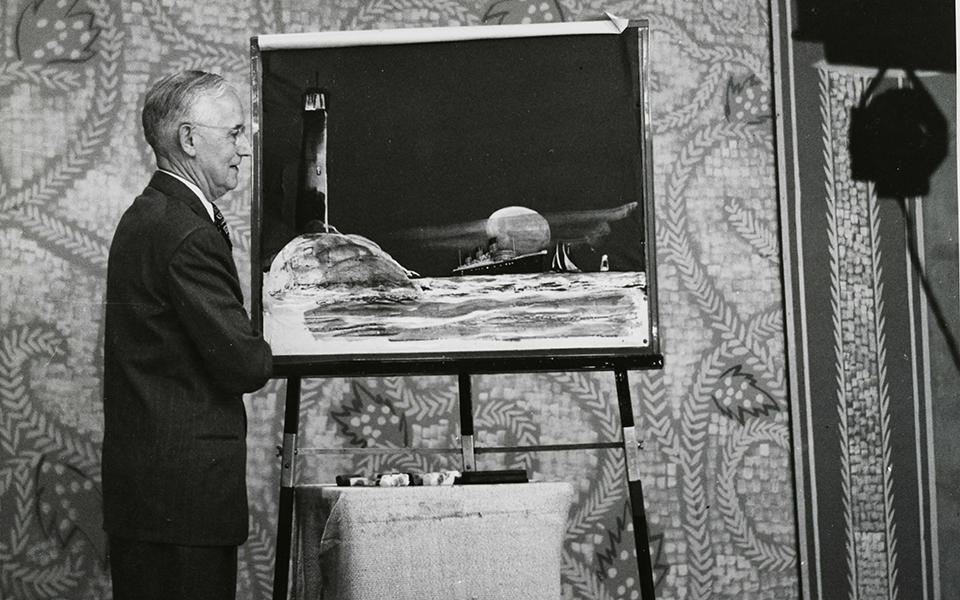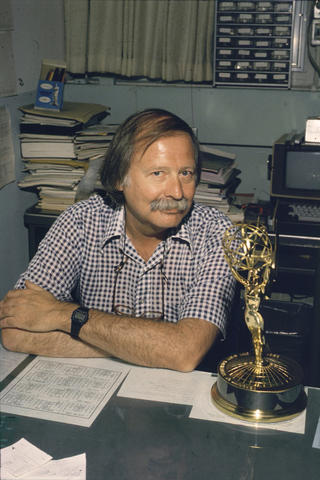Taking Measure
Just a Standard Blog

NIST researcher John Howard Dellinger stands in front of a painting being used as an illustration to explain radio navigation as part of a science segment on the television show "Rainbow Revue." NIST was involved in the development of the LORAN navigation system, a precursor to GPS.
The Academy of Television Arts & Sciences today announced nominations for the 2020 Primetime Emmy Awards, which recognize some of the best TV shows of the year. But before the Emmys could recognize the best actors, actresses and shows, television itself had to be invented. The National Institute of Standards and Technology (NIST) has played a role in television throughout the decades and was there from the very beginning.
First TV Broadcast
On June 13, 1925, inventor C. Francis Jenkins made the first U.S. demonstration of a TV broadcast for a handful of distinguished government officials and scientists. The picture, which showed a small model of a windmill with blades in motion, was broadcast from the Naval Air Station in Washington, D.C., and displayed on a 20.32 centimeter by 25.4 centimeter (8 inch by 10 inch) screen in Jenkins’ laboratory, 8.85 kilometers (5.5 miles) away.
Some suggested calling the new device the “telarama,” which meant distant viewing, but Jenkins suggested naming it “telaramaphone,” which meant distant viewing and hearing (thankfully neither name stuck). Among the select members of the group who viewed the demonstration was George K. Burgess, director of the National Bureau of Standards (NBS), the agency that became NIST.
‘Rainbow Revue’
NIST would go on to play a more active role a few decades later when color television first came on the scene. During the early 1950s, NIST was part of a show called the “Rainbow Revue,” which was one of the earliest color TV broadcasts and part of an effort by the Federal Communications Commission (FCC) to determine which color TV technology should be adopted as the standard.
The show lasted an hour and was a combination variety and educational program. Baritone Gene Archer and soprano Jeanne Warner were the hosts. The program was broken down into four main segments that included musical acts and ran every day throughout the week. The segments featured content from an assortment of government departments, such as a sewing series by the U.S. Department of Agriculture.
NIST had a science series within the show and presented a number of topics ranging from textiles to low-temperature physics. The 10-minute segment would feature the NIST scientist demonstrating a scientific apparatus or explaining research relating to the topic. Even NIST’s own director, Allen V. Astin, appeared on the show.
Three companies, CBS, RCA and Color Television Inc., were competing against each other to develop the best color TV technology. The FCC formed committees to study, test and report on the various systems. One of the committees was led by NIST director at the time, Edward Condon, and a separate study took place to determine color TV technology standards.
The FCC ruled in favor of CBS and gave its approval for the company to use its technology to broadcast in color. However, because the other two companies did not agree with the decision, the case went all the way up to the Supreme Court, which ruled in favor of the FCC.
Inventing Closed Captioning
In 1970, NIST started laying the groundwork for closed captioning technology. Researchers developed a time distribution system called TvTime that placed a hidden time code on an unused part of the television signal. A signal decoder in the television set then recovered and displayed the time. The system itself wasn’t implemented, but it provided the basis for what was to become closed captioning.
NIST and ABC began experimentally transmitting captions shortly thereafter. A demonstration was held for the National Conference on Television for the Hearing Impaired in 1972. At the conference, they showed an episode of Mod Squad that had been captioned by NIST employee Sandra Howe. In the following years, the Public Broadcasting Service (PBS) collaborated with NIST and took up the project on closed captioning and developed convenient encoding equipment and improvements to the captioning format.
In 1980, ABC, NBC and PBS began transmitting closed captions on selected programs, and decoders went on sale to the public. This coincided with the establishment of the National Captioning Institute, which is still responsible for much of today’s captioning.
NIST Receives an Emmy

In September 1980, NIST, along with ABC and PBS, received an Emmy for the development of the decoders and transmitting closed captions. The NIST staff responsible for the work included Dick Davis, Jim Jespersen and George Kamas. The team was later invited to the White House to meet with President Jimmy Carter and receive his congratulations.
Closed captioning eventually would become standardized. In 1990, President George H.W. Bush signed a bill that required all television sets 13 inches or larger sold in the United States to have the capability to display closed captions.
As shown from all the examples above, NIST has played a role in TV throughout the decades. But the involvement didn’t end with an Emmy Award. NIST continues to contribute to the field, including more recent research on making flat-screen televisions, laptops and other light-emitting appliances more energy efficient, and creating color standards for LED lighting, which are now used in high-resolution TVs.





